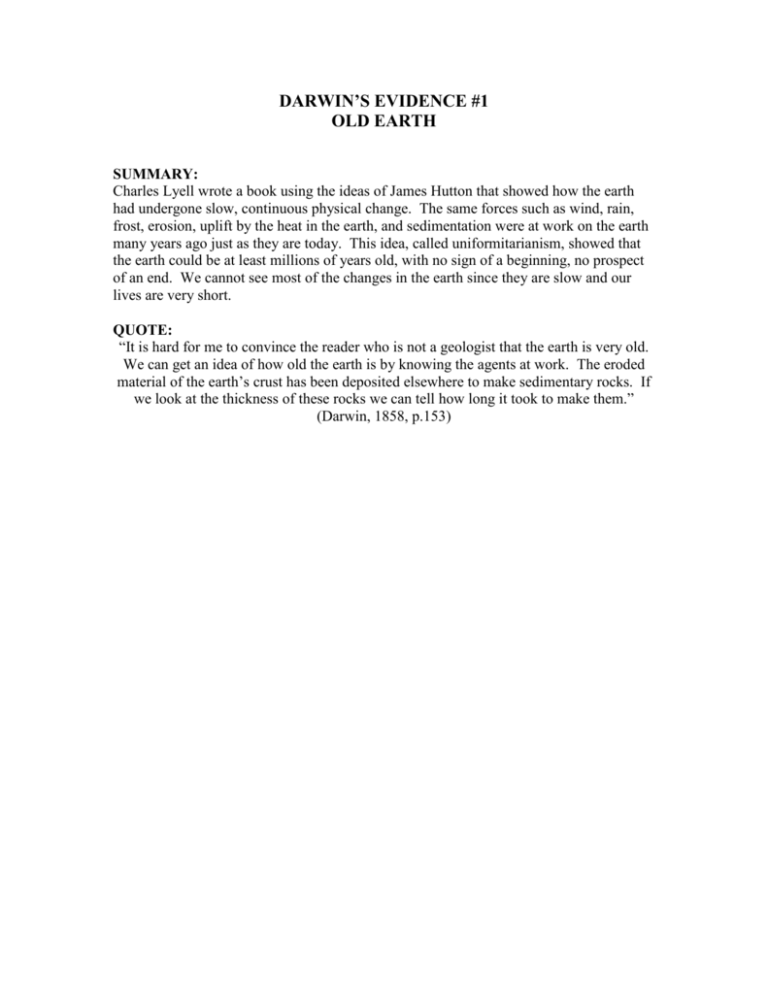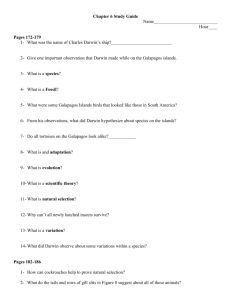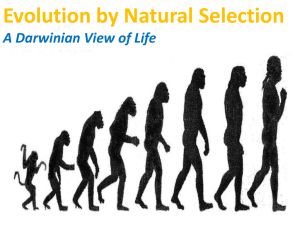Darwin`s Evidence 1
advertisement

DARWIN’S EVIDENCE #1 OLD EARTH SUMMARY: Charles Lyell wrote a book using the ideas of James Hutton that showed how the earth had undergone slow, continuous physical change. The same forces such as wind, rain, frost, erosion, uplift by the heat in the earth, and sedimentation were at work on the earth many years ago just as they are today. This idea, called uniformitarianism, showed that the earth could be at least millions of years old, with no sign of a beginning, no prospect of an end. We cannot see most of the changes in the earth since they are slow and our lives are very short. QUOTE: “It is hard for me to convince the reader who is not a geologist that the earth is very old. We can get an idea of how old the earth is by knowing the agents at work. The eroded material of the earth’s crust has been deposited elsewhere to make sedimentary rocks. If we look at the thickness of these rocks we can tell how long it took to make them.” (Darwin, 1858, p.153) DARWIN’S EVIDENCE #2 FOSSILS SUMMARY: Even though there were large gaps in the fossil record, there were some fossil series known that showed a gradual change in living things from one kind to another. There were also fossils that were identical species to those that were alive today. QUOTE: “Every year tends to fill up the blanks in the fossil record and to make the gap between the lost and existing forms less and less…If we compare any but the most closely related rock layers, all the species will be found to have undergone some change.” (Darwin, 1858, p.166) These snails illustrate a smooth series of intermediate fossils from the oldest known ancestors to present-day forms. The transitions along the way are gradual, often making it difficult to divide the lineage into distinct species. Fossils of Trilobites, which are extinct. DARWIN’S EVIDENCE # 3 VESTIGIAL ORGANS SUMMARY: Living animals contained small remnants (leftovers) of organs that did not do anything. Flightless insects, for instance, are often equipped with tiny functionless wings. Certain snakes keep pieces of useless legs. QUOTE: “The eyes of moles and of some burrowing rodents are small in size, and in some cases are covered up by skin and fur. Since frequent irritation of the eyes must injure the animal, and animals that live underground can get along without eyes, reducing the size, sealing together the eyelids and growing fur over them might be an advantage.” “Organs or parts which seem useless are very common in nature. In many snakes there are small bones of the pelvis and hind limbs. Unborn whales have teeth, but when grown up they do not have a tooth in their head. There are many insects with wings so small that they cannot fly, and sometimes the wings are covered with wing cases that are sealed together so that the wings cannot be used.” (Darwin, 1858, p.428) DARWIN’S EVIDENCE #4 HOMOLOGOUS STRUCTURES SUMMARY: Darwin was struck by the fact “that the hand of a man formed for grasping, that of a mole for digging, the leg of the horse, the paddle of the porpoise, and the wing of the bat, should all be constructed on the same pattern, and should include the same bones in the same relative positions.” (Darwin, 1858, p.208) QUOTE: “We see the same great law in the construction of the mouths of insects. What can be more different than the very long spiral trunk-like mouth of a sphinx-moth, the curious folded one of a bee or bug, and the great jaws of a beetle? Yet all these mouths, serving such different purposes, are formed of an upper lip, mandibles and two pair of maxillae.” (Darwin, 1858, p.416) whale Lion Human Bat Horse DARWIN’S EVIDENCE #5 EMBRYOLOGY SUMMARY: Biologists saw that as embryos developed they went through stages that resembled the adult forms of more primitive types. For example, human embryos have gill slits similar to those of a fish. There are stages where it is almost impossible to tell the difference between the embryos of reptiles, birds, and mammals. QUOTE: “Certain organs in the individual which in the full-grown animal are very different and do different things, are exactly alike in the embryo…Agassiz, having forgotten to label the embryo of some vertebrate animal, cannot tell now whether it is a mammal, bird or reptile.” (Darwin, 1858, p.419) DARWIN'S EVIDENCE #6 ANIMAL AND PLANT BREEDING OR ARTIFICIAL SELECTION SUMMARY: Selective breeding of animals and plants is when humans choose which plants or animals to breed. This gives a great variety of different kinds. Many of these differences are inherited from one generation to the next. QUOTES: "No one supposes that our best domestic plants and animals have been produced by a single difference from the original plant or animal... We see an astonishing improvement in many florists' flowers when the flowers of the present day are compared with drawings made only twenty or thirty years ago. When a race of plants is once pretty well established, the seed-raisers do not pick out the best plants, but merely go over their seed-bed, and pull up the "rogues" as they call the plants that are different from the original. With animals this kind of selection is, in fact, likewise followed; for hardly anyone is so careless as to breed from his worst animals." (Darwin, 1858, p.49) "No one would ever expect to get a first-rate heartsease or dalia (garden flowers) from the seed of a wild plant. The final result happens when people cultivate the best-known variety, sow its seeds, and, when a slightly better variety chanced to appear, selecting it, and so on. Slowly accumulating a large amount of change explains the well-known fact that in a number of cases we cannot recognize the wild parent-stocks (versions) of the plants which we grow in our flower gardens." (Darwin, 1858, p.52-53) By a similar process of selection, and by careful training, English racehorses have gotten faster and bigger than the parent Arab ... Lord Spencer and others have shown how the cattle of England have increased in weight and mature earlier when compared with the stock that they used to keep in this country ... By comparing the historical accounts and current descriptions of the carrier and tumbler pigeons in Britain, India and Persia, we can trace the stages through which they have ... passed, and come to differ so greatly from the rock-pigeon. (Darwin, 1858, p.51) Fancy pigeon breeds of one of the London pigeon clubs to which Darwin belonged. DARWIN'S EVIDENCE #7 THE SUCCESSION OF TYPES SUMMARY: In South America, Darwin found fossils of an extinct armadillo that was very similar to living armadillos. He also found the fossils of the extinct ground sloth to be similar to the living sloth. The extinct forms were much larger, but Darwin thought that their resemblance was too close to be accidental. EXTINCT GROUND SLOTH SLOTH (PRESENT DAY) EXTINCT GIANT GLYPTODON Armadillo (Present Day) QUOTE: "Mr. Clift many years ago showed that the fossil mammals from the Australian coves were closely related to the living marsupials of that continent. In South America a similar relationship is seen in the fossils of the gigantic pieces of armor of the glyptodont which are like those of the living armadillo. Most of the fossil mammals buried in South America are related to living animals. In the caves of Brazil there are many extinct species closely related to the species still living in South America. I was so much impressed with these facts on this wonderful relationship on the same continent between the dead and the living.” Darwin, 1858, p.174








